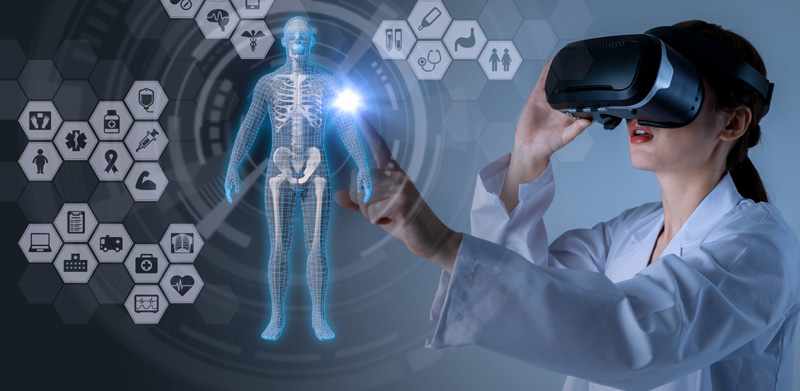
Living in the time of the fourth industrial revolution, technology proves to be a blessing that no person can avoid. The artificial intelligence is being utilized and persistently explored to make it prepared for use in all domains of life and all the more significant in the field of medication where accuracy can mean life or death of a patient. There are various advantages of the utilization of Artificial Intelligence in the medical diagnostic systems.
Artificial Intelligence (AI) is an examination to copy human intelligence into PC innovation. The capability of AI in medicine has been communicated by various analysts. The capability of AI techniques in medicine and diagnosis are many.
Firstly, it provides a research center for the assessment, organization, representation, and cataloging of clinical information. Secondly, it produces new instruments to help clinical dynamics, training, and research. Thirdly, it integrates activities in medical, PC, cognitive, and other different sciences. Fourthly, it offers a content-rich discipline for a future scientific medical specialty. Numerous intelligent frameworks have been created to improve medical care and diagnosis for the purpose of providing superior medical facilities, reducing costs, and others.
It has been accepted by various doctors that artificial intelligence technology has many benefits over other conventional practices because of the way that it can investigate huge datasets at the same time, gives us an unaided discovery that uncovers hidden patterns, and also upgrades the speed by recommending auto-created clinical pathways. Artificial Intelligence is an instrument that can unquestionably help specialists and doctors in early diagnosis and help bring down the death rate and medical inflation.
Diagnosis of diseases is the process of changing observed evidence into the names of diseases. Fundamental to the successful delivery of medical services by the doctor is the complex skill of clinical problem-solving. The precision of this skill is critical to the life and wellbeing of his/her patients. The effectiveness with which it is applied is of incredible economical importance. Applying Artificial Intelligence (AI) methods in the medical field may help not just in improving the precision performance of classification but also in saving diagnostics' time, cost, and the pain attached to pathologies' tests.
There are many applications of Artificial intelligence that vary from image acquisition, aided reporting processing, data mining, follow-up, and data storage, etc. The utilization of machine learning combines computational models and algorithms that copy the biological neural network architecture of the brain, i.e., artificial neural networks (ANNs). On the basis of Output, Deep learning has a much greater rate of success compared to traditional machine learning.
The future of diagnosis will be better and better. The use of the integration of computers and artificial intelligence can change the world of medical diagnosis. Advancement in technology will prove as a reliable platform for the growth of the use of artificial intelligence in diagnosis.
Artificial Intelligence (AI) has developed quickly since the last part of the 1980s. Expanding medical care datasets and its performance, the previous twenty years have seen an exponential improvement in publications on AI. However, with the introduction of expanded computational power, the accessibility of AI devices has been expanded. There are two principle devices in AI, machine learning, where structured information (for example pictures, EP, and genetic information) is examined and natural language handling, where unstructured information is examined.
Both AI devices have been improved in incredible detail in the course of recent decades for their strategies, algorithms, methods, and applications. However, different endeavors and new techniques for AI have been utilized recently and some diseases, for example, malignant growth (cancer), nervous system disease, cardiovascular disease, liver disease, congenital cataract disease, and so forth were possibly examined utilizing AI. Presently, an advanced technique called deep learning has introduced a booming effect of AI and extraordinary modifications on diagnostic medical imaging systems like endoscopic diagnostic, pathology, and dermatology will be anticipated to grow in the next few years.
Neurology had ruled the usage of artificial intelligence in diagnosis. Radiology is anticipated to be the fastest-growing segment because of the development of AI-based applications used for diagnostic imaging. The diagnosis that is based on artificial intelligence includes early detection and accurate diagnosis of various neurological disorders such as autism, Alzheimer’s disease, Parkinson’s disease, ischemic stroke, and multiple sclerosis.
Owing to increasing development and advancements in machine learning methods like artificial intelligence has paved its way in medical diagnostic systems. Due to the numerous benefits of Artificial Intelligence in diagnosis will help in the growth of this market. Understanding the situation in India, low awareness regarding health among the population regularly postpones treatment resulting in the aggravation of protected individuals' medical conditions. At the point when treatment happens, private professionals are inclined to utilize pointless medical procedures and related methodology.
Therefore, it is quite clear that dealing with this area isn't a simple task when different elements are ruling the graph of this industry. This is the place where Artificial Intelligence comes in, with the assistance of these computerized diagnosis algorithms unnecessary treatment can be evaded hence bringing down the inflation. The Global Artificial Intelligence in Diagnostics Market size is expected to rise at a market growth of 27.4% CAGR during the forecast period.